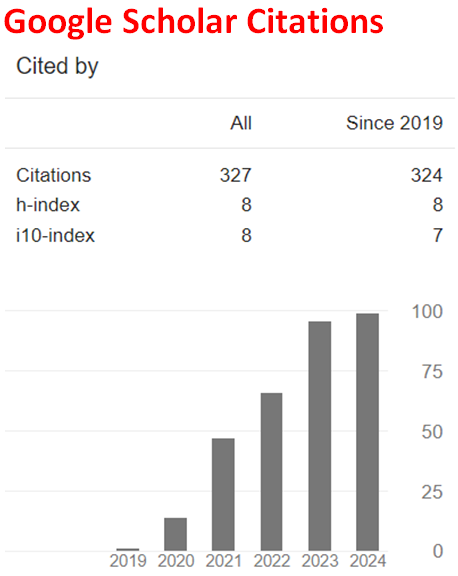DFT Treatment of Hydrazine - Nitroform Interaction
Abstract
In the present study, interaction of hydrazine and nitroform (trinitromethane) has been investigated via some models within the constraints of density functional theory at the level of B3LYP/6-311++G(d,p). The data have revealed that the electronic stability order of the models is 3>1>2>5>4 where model-3 is a cyclic one. The others are acyclic and some of them are ion-pair models. Some geometrical, physico chemical and quantum chemical data have been obtained and discussed. The results, overall, indicate that the interaction between the hydrazine and nitroform in the salt form is not ion-pair type, but the hydrogen of nitroform prefers to be linked to carbon atom, thus some sort of nonbonding interactions occur.
References
Schoyer, H.F.R., Welland-Veltman, W.H.M., Louwers, J., Korting, P.A.O.G., van der Heijden, A.E.D.M., Keizers, H.L.J., & van den Berg, R.P. (2002). Overview of the development of hydrazinium nitroformate. Journal of Propulsion and Power, 18(1), 131 137. https://doi.org/10.2514/2.5908
Dendage, P.S., Sarwade, D.B., Asthana, S.N., & Singh, H. (2001). Hydrazinium nitroformate (HNF) and HNF based propellants: A review, Journal of Energetic Materials, 19(1), 41-78. https://doi.org/10.1080/07370650108219392
Dickens, B. (1967). Crystal structure of hydrazine nitroform [N2H5+C(NO2)3−], Chemical Communications, 5, 246-247. https://doi.org/10.1039/C19670000246
Ledgard, J. (2007). The preparatory manual of explosives. ISBN 9780615142906
Du, L., Jin, S., Liu, Y., Wang, M., Li, J., Lan, G., Nie, P., & Li, L. (2019). Theoretical study on the weak interaction and energy performance of nitroformate salts and nitroformate-based propellant formulations, Journal of Molecular Modeling, 25, 285, 1 10. https://doi.org/10.1007/s00894-019-4164-7
Göbel, M., & Klapötke, T.M. (2007). Potassium-, ammonium-, hydrazinium-, guanidinium-, aminoguanidinium-, diaminoguanidinium-,triaminoguanidinium- and melaminium nitroformate – synthesis, characterization and energetic properties, Z. Anorg. Allg. Chem., 633, 1006-1017. https://doi.org/10.1002/zaac.200700114
Baxter, A.F., Martin, I., Christe, K.O., & Haiges, R. (2018). Formamidinium nitroformate: an insensitive RDX alternative, J. Am. Chem. Soc. 140, 15089-15098. https://doi.org/10.1021/jacs.8b10200
Huang, Y., Gao, H., Twamley, B., & Shreeve, J.M. (2007). Synthesis and characterization of new energetic nitroformate salts, Eur. J. Inorg. Chem., 14, 2025-2030. https://doi.org/10.1002/ejic.200601228
Göbel, M., Klapötke, T.M., & Mayer, P. (2006). Crystal structures of the potassium and silver salts of nitroform, Z. Anorg. Allg. Chem., 632, 1043-1050. https://doi.org/10.1002/zaac.200500525
Yang, L., Zhang, J., Zhang, T., Zhang, J., & Cui, Y. (2009). Crystal structures, thermal decompositions and sensitivity properties of [Cu(ethylenediamine)2(nitroformate)2] and [Cd(ethylenediamine)3] (nitroformate)2, J. Hazard. Mater., 164, 962-967. https://doi.org/10.1016/j.jhazmat.2008.08.096
Bryan, J.C., Burnett, M.N., & Gakh, A.A. (1998). Tetrabutylammonium and caesium salts of trinitromethane, Acta Cryst. C54, 1229-1233. https://doi.org/10.1107/S0108270198004491
Cioslowski, J., Mixon, S.T., & Fleischmann, E.D. (1991). Electronic structures of trifluoro-, tricyano-, and trinitromethane and their conjugate bases, J. Am. Chem. Soc. 113, 4751-4755. https://doi.org/10.1021/ja00013a007
Ju, X-H., Xiao, J-J., & Xiao, H-M. (2003). DFT Study of the intermolecular interaction of hydrazinium nitroformate ion pair, Chemical Journal of Chinese Universities, 24(6), 1067-1071. http://www.cjcu.jlu.edu.cn/CN/Y2003/V24/I6/1067
Urbanski, T. (1984). Chemistry and technology of explosives (Vol. 4). Oxford: Pergamon, UK. https://doi.org/10.1002/ijch.196400070
Jones, J.R. (1972). The ionization of carbon acids, In Annual Reports on the Progress of Chemistry, Section A: General Physical and Inorganic Chemistry (Ch.5, Vol. 69, pp. 119-132). London: Academic.
Murray, J.S., Lane, P., Göbel, M., Klapötke, T.M., & Politzer, P. (2009). Intra- and intermolecular electrostatic interactions and their significance for the structure, acidity, and tautomerization behavior of trinitromethane, The Journal of Chemical Physics, 130, 104304. https://doi.org/10.1063/1.3082406
Stewart, J.J.P. (1989). Optimization of parameters for semiempirical methods I. Method. J. Comput. Chem., 10, 209-220. https://doi.org/10.1002/jcc.540100208
Stewart, J.J.P. (1989). Optimization of parameters for semiempirical methods II. Application. J. Comput. Chem., 10, 221-264. https://doi.org/10.1002/jcc.540100209
Leach, A.R. (1997). Molecular modeling. Essex: Longman.
Fletcher, P. (1990). Practical methods of optimization. New York: Wiley.
Kohn, W., & Sham, L. (1965). Self-consistent equations including exchange and correlation effects. J. Phys. Rev., 140, A1133-A1138. https://doi.org/10.1103/PhysRev.140.A1133
Parr R.G., & Yang, W. (1989). Density functional theory of atoms and molecules. London: Oxford University Press.
Cramer, C.J. (2004). Essentials of computational chemistry. Chichester, West Sussex: Wiley.
Becke, A.D. (1988). Density-functional exchange-energy approximation with correct asymptotic behavior. Phys. Rev. A, 38, 3098-3100. https://doi.org/10.1103/PhysRevA.38.3098
Vosko, S.H., Wilk, L., & Nusair, M. (1980). Accurate spin-dependent electron liquid correlation energies for local spin density calculations: a critical analysis. Can. J. Phys., 58, 1200-1211. https://doi.org/10.1139/p80-159
Lee, C., Yang, W., & Parr, R.G. (1988). Development of the Colle-Salvetti correlation energy formula into a functional of the electron density. Phys. Rev. B, 37, 785-789. https://doi.org/10.1103/PhysRevB.37.785
SPARTAN 06 (2006). Wavefunction Inc., Irvine CA, USA.

This work is licensed under a Creative Commons Attribution 4.0 International License.


